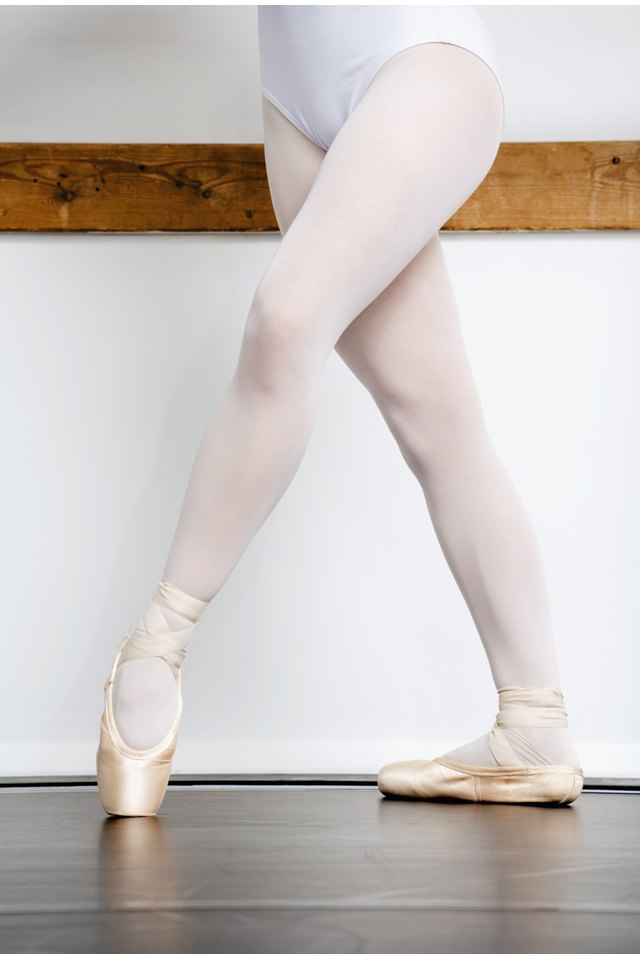How to Develop Calf Muscles Like a Ballet Dancer

Ballet dancers spend years toning their bodies and performing maneuvers that seem to defy the laws of physics. The toned calves of an experienced ballet dancer are objects of envy and the products of years of work. But you don't have to spend years dancing to get lovely calves. Simply take a few cues from the ballet dancer's handbook and use modified versions of dance workouts. Dancing on your toes, or on pointe, is dangerous without training and practice and as such, you should avoid doing this without proper training. If you are interested in ballet, consider taking a beginner-level ballet class for adults.
Learn ballet positions. These positions are starting points for many ballet steps -- and using them will give you a better workout. In first position, the heels are touching, while the balls of the feet are turned out, and the legs completely straight. Second position requires the same foot placement as first position, but the length of one foot separates the heels. In third position, one foot is in front of the other, with the heel of the front foot intersecting the arch of the rear foot. To achieve fourth position, keep your feet in the same configuration as third position, but move the front foot approximately a foot away from the back foot. In fifth position, one foot is in front, with the toes of the back foot touching the heel of the front. Practice putting your legs in these positions. This will increase muscle memory and provide a warm-up for your workout.
Stretch before you begin a leg workout. Flexibility is an important part of ballet and can improve overall muscle tone. More importantly, stretching reduces your risk of injury. Sit on the ground with your legs extended directly in front of you. Bend over as far as you can to touch your toes. Hold for five to 10 seconds and repeat five times. Then repeat the same maneuver, but with one leg moved out to the side, bending sideways to touch the toes. Repeat with the other leg.
Perform a a releve. Releves are ballet maneuvers in which the dancer starts in a ballet position and rises up on the pointe, which means on the toes, or demi-pointe, which means on the balls of the feet. Since beginners should not attempt to stand on their toes, stand in first position and gradually lift your heels off the floor while balancing on the balls of your feet. Steady yourself by gripping a chair or ballet barre with one hand, hold for two seconds, then slowly lower your feet back to the ground. Repeat in each position at least five times.
Rise into a releve and then perform a plié. A plié is the gradual lowering of the body so that the knees are bent. Staying on the balls of your feet extends this workout from your thighs down to your calves. While in a releve, bend your knees, gradually lowering your rear and thighs. Keep your upper body straight. Hold for two seconds then gradually exit the plié. Beginners should perform this exercise by placing a ballet barre or chair in front of their bodies and gripping with both hands. Do not place your weight on the barre or chair; simply use it to steady yourself.
Perform calf lifts while wearing ankle weights to strengthen your calves and increase your endurance while performing ballet exercises. Sit in a chair with your feet flat on the ground and your knees bent. Gradually raise one foot until your leg is straight in front of you. Do not lift your thighs off the chair, or move your torso downward. Then repeat with the other leg. Start with five reps, held for two seconds, on each side and gradually increase the number of reps and the time you hold the calf lift.
References
- NYC Ballet Workout; Peter Martins
- Dancing Longer, Dancing Stronger; Andrea Watkins et al.
- The Ballet Companion; Eliza Gaynor Minden
- Ballet Beautiful; Mary Helen Bowers
- Classical Ballet News: How to Releve in Ballet
Writer Bio
Brenna Davis is a professional writer who covers parenting, pets, health and legal topics. Her articles have appeared in a variety of newspapers and magazines as well as on websites. She is a court-appointed special advocate and is certified in crisis counseling and child and infant nutrition. She holds degrees in developmental psychology and philosophy from Georgia State University.
